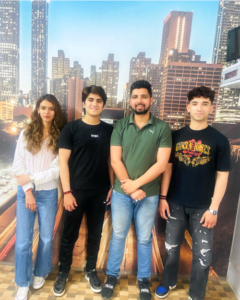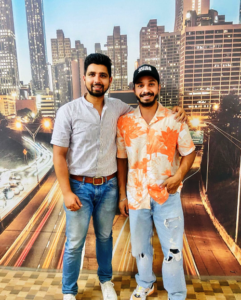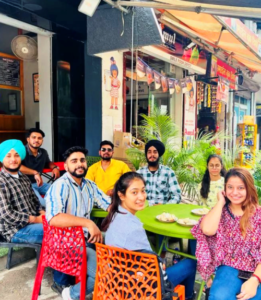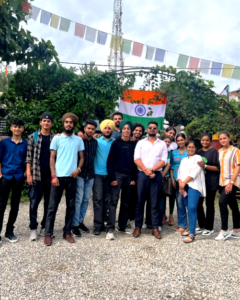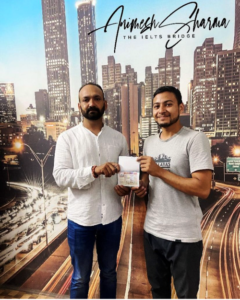Section 1: Young Fashion Designer UK competition
Questions 1-7: TRUE, FALSE, NOT GIVEN
[In this type of question, candidates are asked to find out whether:
The statement in the question agrees with the information in the passage – TRUE
The statement in the question contradicts with the information in the passage – FALSE
If there is no information on this – NOT GIVEN
For this type of question, you can divide each statement into three independent pieces and make your way through with the answer.]
Question 1: Participants are required to create a new item of clothing for the Young Fashion Designer UK competition.
Keywords for this question: Participants, required to create, new item of clothing,
In the second paragraph, the writer of the text says in lines 1-2, “The competition is designed for students to enter the coursework they are currently working on rather than specifically producing different pieces of work. .. ..”
Here, rather than specifically producing different pieces of work = Participants are NOT required to create a new item of clothing,
So, the answer is: FALSE
Question 2: Participants must send information about the thoughts that led to the item they are entering for the competition.
Keywords for this question: Participants must send, information, thoughts that led to, item,
In the third paragraph, the writer describes the requirements to enter the competition. Take a close look at the first requirement,
“ 1) Provide three A3 colour copies from your design folder.
You must include:
- Initial ideas about the clothing
- A close-up photograph of the front and back view of the finished clothing.
Here, Initial ideas about the clothing = the thoughts that led to the item they are entering for the competition,
So, the answer is: TRUE
Question 3: The shortlist will consist of a fixed number of finalists.
Keywords for this question: shortlist, will consist of, fixed number, finalists,
We find the keyword ‘shortlist’ in the first line of paragraph no. 4. However, the paragraph doesn’t say anything about any fixed number of finalists.
This means the information is NOT GIVEN in the paragraph.
So, the answer is: NOT GIVEN
Question 4: Finalists can choose how to present their work to the judges on their stand.
Keywords for this question: Finalists can choose, how to present, their work, judges, their stand,
In paragraph no. 4, look at lines 3-5, “ . … Each finalist will have their own stand consisting of a table and tabletop cardboard display panel. Feel free to add as much creativity to your stand as possible. .. . .”
Here, Feel free to add as much creativity to your stand as possible = finalists can choose how to present their work . .. . on their stand,
So, the answer is: TRUE
Question 5: It is strongly recommended that finalists support their entry with additional photographs.
Keywords for this question: strongly recommended, finalists support, their entry, additional photographs,
Again, in paragraph no. 4, look at lines 5-7, “ . … Some students bring tablets/ laptops with slideshows or further images of work but it should be emphasised that these may not necessarily improve your chances of success.”
Here, further images = additional photographs, it should be emphasised that these may not necessarily improve your chances of success = NOT strongly recommended,
So, the answer is: FALSE
Question 6: Questions that the students ask the judges may count towards the final decisions.
Keywords for this question: questions, students, ask the judges, may count, towards, final decisions,
In the fifth paragraph, take a look at lines 3-4, “ . .. . You are welcome to ask the judges questions. In fact, you should make the most of having experts on hand.”
Here, there’s NO INFORMATION on whether asking questions may count towards the final decisions or not.
So, the answer is: NOT GIVEN
Question 7: Extra prizes may be awarded depending on the standard of the entries submitted.
Keywords for this question: extra prizes, may be awarded, depending on, standard, entries submitted,
In the final paragraph, have a close look at lines 1-2, “There are 1st, 2nd and 3rd prize winners for each category. The judges can also decide to award special prizes if the work merits this. . .. .”
Here, The judges can also decide to award special prizes if the work merits this = Extra prizes may be awarded depending on the standard of the entries submitted,
So, the answer is: TRUE
Questions 8-14: Which keyboard should you buy?
Questions 8-14: Identifying information:
[This question asks you to find information from the passage and write the number of the paragraph (A, B, C or D … .. ) in the answer sheet. Now, if the question is given in the very first part of the question set, I’d request you not to answer them. It’s mainly because this question will not follow any sequence, and so it will surely kill your time. Rather, you should answer all the other questions first. And just like List of Headings, only read the first two lines or last two lines of the expected paragraph initially. If you find the answers, you need not read the middle part. If you don’t find answers yet, you can skim the middle part of the paragraph. Keywords will be a useful matter here.]
Question 8: This keyboard may not suit users who prefer the keys to be almost silent.
Keywords for this question: may not suit, users, prefer, keys, to be almost silent,
In the description of Keyboard B (Cherry MX 3.0 Keyboard), have a close look at line no. 3, “ . . .. It’s also rather loud though, which can take some getting used to.”
Here, rather loud = may not suit users who prefer the keys to be almost silent,
So, the answer is: B
Question 9: This keyboard is easily portable because it can be made to fit into a small space.
Keywords for this question: easily portable, because, can be made, to fit into, small space,
In the description of Keyboard E (Microsoft Universal Bluetooth Keyboard), the author of the text says in the first lines, “Microsoft’s Bluetooth keyboard has one very handy feature – you can fold it in half and carry it around in your jacket pocket or bag. .. .. .”
Here, you can fold it in half = can be made fit into a small space, carry it around = easily portable,
So, the answer is: E
Question 10: This keyboard includes a special place to put small devices.
Keywords for this question: includes a special place, put, small devices,
In the description of Keyboard C (Logitech K780), the author of the text says in lines 1-2, “ . .. . There’s an integrated stand for smartphones and tablets too. .. . ..”
Here, an integrated stand = a special place, smartphones and tablets = small devices,
So, the answer is: C
Question 11: This Keyboard is designed to prevent injury to those who spend a lot of time on the computer.
Keywords for this question: designed, to prevent injury, who spend, a lot of time, on the computer,
In the description of Keyboard D (Microsoft Sculpt Ergonomic), the author says in lines 1-3, “. … .. It provides wrist support and lifts your forearms into a relaxed position so you don’t hurt yourself from typing for lengthy periods. . . .”
Here, you don’t hurt yourself = prevent injury, typing for lengthy periods = spend a lot of time on the computer,
So, the answer is: D
Question 12: This keyboard offers good value for money.
Keywords for this question: offers, good value for money,
In the description of Keyboard A (Logitech K120), the author says in line no. 3, “ . … . For the price, it’s a tempting choice.”
Here, For the price, it’s a tempting choice = offers good value for money,
So the answer is: A
Question 13: This keyboard is primarily aimed at people who use their computer for entertainment.
Keywords for this question: primarily aimed at, people who use, computer, for entertainment,
In the description of Keyboard F (Corsair Strafe RGB Keyboard), the author says in line no. 3, “ . … .. All this is because it’s designed for gamers. … …”
Here, it’s designed for gamers = primarily aimed at people who use their computer for entertainment,
So the answer is: F
Question 14: It shouldn’t take long for users to get used to the shape of the keys on this keyboard.
Keywords for this question: shouldn’t take long, users, to get used to, the shape of the keys,
In the description of Keyboard C (Logitech K780), the author of the text says in lines 3-4, “ . .. . and the circular keys are easy to familiarise yourself with, well-spaced and large enough to hit accurately. .. ..”
Here, easy to familiarise yourself with = It shouldn’t take long for users to get used to,
the circular keys .. .. . well-spaced and large enough to hit accurately = the shape of the keys,
So the answer is: C
Section 2: Working for a small company may be better than you think
Questions 15-20: Completing sentences with ONE WORD ONLY:
[In this type of question, candidates are asked to write a maximum of one word to complete sentences on the given topic. For this type of question, first, skim the passage to find the keywords in the paragraph concerned with the answer, and then scan to find the exact word.
TIPS: Here scanning technique will come in handy. Target the keywords of the questions to find the answers. Remember to focus on Proper nouns, random Capital letters, numbers, special characters of text, etc.]
Question 15: In a small business it is easy to become _______ with colleagues and other departments.
Keywords for this question:small business, easy to become, colleagues and other departments,
In the second paragraph of the text, the first lines say, “Working in a small organisation with a small workforce means it’s likely to be easy to become part of it. It won’t be long before you’re familiar with the staff and the departments that you need to deal with. . … .”
Here, the staff = colleagues, the departments that you need to deal with = other departments,
So, the answer is: familiar
Question 16: You may find you have ________ you were not aware.
Keywords for this question:may find, have, were not aware,
In the third paragraph, lines 1-3 say, “In a small business you’re likely to have considerable variety in your workload, including opportunities to work in different areas of the company, which will allow you to identify abilities that you didn’t know you had. .. ..”
Here, identify = find, you didn’t know = you were not aware,
So, the answer is: abilities
Question 17: Finding that your work is ________ will make you enjoy doing it.
Keywords for this question:Finding, will make, enjoy doing it,
Take a look at lines 4-5 of paragraph no. 3, “.. .. . This variety in your work will help to make it stimulating, so you have a good reason for getting out of bed in the morning.”
Here, you have a good reason for getting out of bed in the morning = make you enjoy doing it,
So, the answer is: stimulating
Question 18: Other people are likely to realise that you have ______.
Keywords for this question:Other people, likely to realise, have,
In lines 2-5 in the fourth paragraph, the author of the text says, “. .. . Because it’s much harder to overlook someone within a small workforce than a large one, your efforts are more likely to attract the attention of those higher up. You’ll have plenty of opportunities to show what you can do, and to have your potential noticed. … ..”
Here, more likely to attract the attention of those higher up = other people are likely to realise,
So, the answer is: potential
Question 19: Opportunities for ________ will come sooner than in a larger business.
Keywords for this question:Opportunities, will come sooner, than, larger business,
The last line of paragraph no. 4 says, “ .. . . The result is very likely to be that promotion comes to you faster.
Here, comes to you faster = come sooner,
So, the answer is: promotion
Question 20: You can benefit from a small company being more _______ than a large one.
Keywords for this question:can benefit from, small company, being, more, than, large one,
In the final paragraph (paragraph no. 5), have a close look at the first lines, “Small businesses are usually flexible, something that is rarely true of large organisations. This means that if they’re well managed, they can adapt to make the most of changes in the wider economy, which in turn can help you.”
Here, is rarely true of large organisations = small companies are more flexible than large companies, can help you = you can benefit from a small company,
So, the answer is: flexible
Starting a new job
Questions 21-27: Identifying information
[This question asks you to find information from the passage and write the number of the paragraph (A, B, C or D … .. ) in the answer sheet. Now, if the question is given in the very first part of the question set, I’d request you not to answer them. It’s mainly because this question will not follow any sequence, and so it will surely kill your time. Rather, you should answer all the other questions first. And just like List of Headings, only read the first two lines or last two lines of the expected paragraph initially. If you find the answers, you need not read the middle part. If you don’t find answers yet, you can skim the middle part of the paragraph. Keywords will be a useful matter here.]
Question 21: the emotions that new employees are likely to experience at first
Keywords for this question:emotions, new employees, likely to experience, at first,
The answer can be found in paragraph C. Take a look at the first lines, “It can be a shock to join a new organisation. When you are a newcomer, feeling uncertain and perhaps a little confused, .. . ..”
Here, shock & feeling uncertain and perhaps a little confused = the emotions,
So, the answer is: C
Question 22: a warning to be patient at first
Keywords for this question:warning, be patient, at first,
Paragraph F starts with a warning, “Don’t try to do the job too soon. .. .. .”
Here, Don’t try to do .. .. . too soon = be patient,
So, the answer is: F
Question 23: how colleagues might react to certain behaviour
Keywords for this question:how, colleagues, might react, certain behaviour,
In paragraph C, the writer of the text says in lines 2-6, “ . .. .. .. there can be a strong temptation to talk about your old job and organisation as a way of reminding yourself and telling others that you really know what you are doing, because you did it in your previous role. Unfortunately, this will suggest that you have a high opinion of yourself, and that you think your old place was better. It has enormous power to annoy, .. ..”
Here, the lines suggest that your colleagues might be feeling annoyed when you are talking about your previous job and organisation.
So, the answer is: C
Question 24: travelling to your new workplace before you start working there
Keywords for this question:travelling to, new workplace, before, start working, there,
In paragraph A, the writer says in the beginning, “Make sure you know when and where you are expected to report on your first day. If the route from home is unfamiliar to you, make a practice run first; .. .. .”
Here, practice run first = travelling to new workplace before start working,
So, the answer is: A
Question 25: an example of observing an activity carried out within an organisation
Keywords for this question:example, observing, an activity, carried out, within, organisation,
In paragraph E, the writer of the text shares his or her own work experience, “When I worked for a television company, all of us, whatever our job, were strongly encouraged to visit a studio and see how programmes were made. .. .”
Here, and see how programmes were made = observing an activity carried out within an organisation,
So, the answer is: E
Question 26: some things that the organisation should arrange for when you begin
Keywords for this answer: some things, organisation, should arrange for, when, begin,
In paragraph B, the writer says, “You should expect to have an induction programme planned for you; a security pass; visits to whatever parts of the organisation you need to understand to do your job properly; .. . . .”
Here, an induction programme, security pass, visits to whatever parts of the organisation = some things … . organisation should arrange for you,
So, the answer is: B
Question 27: a division of jobs within an organisation into two categories
Keywords for this answer: division of jobs, within, organisation, two categories,
Take a look at the first line of paragraph D, “All employers have a core product or service paid for by customers
. .. .. .”
Here, core product & service are the division of jobs into two categories.
So, the answer is: D
Section 3: How animals keep fit
Questions 28-30: Multiple choice questions
[This type of question asks you to choose a suitable answer from the options using the knowledge you gained from the passage. Generally, this question is set found as the last question set in most passages so you should not worry much about it. Finding all the answers to previous questions gives you a good idea about these questions.]
Question 28: The writer discusses marathon runners and barnacle geese to introduce the idea that
Keywords for this question: marathon runners, barnacle geese, to introduce the idea,
In the first paragraph, the writer talks about marathon runners and says, “ … .. . But no matter how well they have stuck to their training regime, contestants will find that running non-stop for 42 kilometres is going to hurt.”
Here, running non-stop for 42 kilometres is going to hurt means that serious training hurts human beings.
Then, in paragraph no. 2, the writer says, “Now consider the barnacle goose. Every year this bird carries out a 3000-kilometre migration. So how do the birds prepare for this? . . .. . . . . Instead, says environmental physiologist Lewis Halsey, ‘They just basically sit on the water and eat a lot.’”
Here, They just basically sit on the water and eat a lot = serious training is not always necessary for physical achievement,
So, the answer is: D (serious training is not always necessary for physical achievement.)
Question 29: The writer says that human muscles
Keywords for this question: human muscles,
The answer can be traced in paragraph no. 9, in lines 1-5, “Our ancestors’ lives were unpredictable. They had to do a lot of running to catch food and escape danger, but they also needed to keep muscle mass to a minimum because muscle is biologically expensive. Each kilogram contributes about 10 to 15 kilocalories a day to our metabolism when resting – which doesn’t sound like much until you realise that muscles account for about 40 percent of the average person’s body mass. .. .”
Here, these lines suggest that human muscles use up massive energy when the body takes rest.
So, the answer is: A (use up a lot of energy even when resting.)
Question 30: The writer says that in order to survive, early humans developed the ability to
Keywords for this question: in order to survive, early humans, developed, the ability,
Again, the answer can be found in paragraph no. 9, in lines 1-2, “Our ancestors’ lives were unpredictable. They had to do a lot of running to catch food and escape danger, .. .”
Here, Our ancestors = early humans, had to do a lot of running = run long distances, catch food and escape danger = in order to survive,
So, the answer is: B (run long distances.)
Questions 31-35: Summary completion
[In this kind of question candidates are given a summary for one, two, or three paragraphs with some fill in the blanks questions. Candidates need to find out the related paragraphs by correctly studying the keywords from the questions. Then, they should follow the steps of finding answers to fill in the gaps.]
Title of the summary: What is the key to physical fitness?
Question 31: In biological terms, when an animal is physically fit, its body changes, becoming more powerful and ________.
Keywords for this question: biological terms, animal, physically fit, body changes, becoming, more powerful,
In paragraph no. 6, the writer says in lines 2-3, “. . . .. Biologically speaking, all it means is that the body has undergone changes that make it stronger and more efficient. .. . .”
Here, Biologically speaking = In biological terms, body has undergone changes = body changes, stronger = more powerful,
So, the answer is: efficient
Question 32: For bears, this change may be initially caused by colder weather or a lack of __________, . .. . .
Keywords for this question: bears, this change, may be, initially caused by, colder weather, lack of,
In paragraph no. 6, lines 3-5 say, “… … In animals such as bears these changes appear to be triggered by cues such as falling temperatures or insufficient food. .. ..”
Here, In animals such as bears = for bears, triggered by = initially caused by, falling temperatures = colder weather, insufficient = lack of,
So, the answer is: food
Questions 33 and 34: . . .. . which during 33. _________ causes certain compounds to be released into their 34. _________ and to travel around the body. These compounds appear to prevent muscle loss.
Keywords for this question: during, causes, certain compounds, released into, travel, around the body, these compounds, prevent, muscle loss,
In lines 5-7 of paragraph no.6, the writer says, “. . .. In the months of hibernation, these factors seem to prompt the release of muscle-protecting compounds which are then carried to the bears’ muscles in their blood and prevent muscle loss.”
Here, In the months of = during, release of muscle-protecting compounds = cause certain compounds to be released, in their blood = into their blood,
So, the answers are:
- hibernation
- blood
Question 35: In the case of barnacle geese, the change may be due to a variation in _________.
Keywords for this answer: barnacle geese, change, may be, due to, variation in,
In paragraph no. 7, take a look at the first few lines, “Barnacle geese, Halsey suggests, may be responding to an environmental change such as temperature, which helps their bodies somehow, ‘know’ that a big physical challenge is looming. .. . .”
Here, may be responding to an environmental change = the change may be due to a variation in,
So, the answer is: temperature
Questions 36-40: Matching statements with list of people
[In this type of question, candidates need to relate statements that are given by or link to people in the passage. The rules for finding answers to this sort of question are simple. Just find the name of the person and read around it carefully. Then, give a quick look to check whether there is another statement or idea provided by the same person in the text. If there is, check the reference carefully and decide your answer. Remember, the questions may not follow any sequential order.]
Question 36: One belief about how animals stay fit is possibly untrue.
Keywords for this question: one belief, how animals, stay fit, possibly untrue,
To find the answer to this question, we have to read both paragraphs no. 3 and 4. First, let’s read paragraph no. 3, where the writer says, “Until recently, nobody has really asked whether exercise is as tightly connected to fitness in the rest of the animal kingdom as it is for us. The question is tied up in a broader assumption: that animals maintain fitness because of the exercise they get finding food and escaping predators.”
The paragraph suggests that there has been an assumption (belief) about how animals stay fit.
However, at the beginning of paragraph no. 4, the writer says, “Halsey points out that this may not necessarily be the case. … …”
Here, this may not necessarily be the case = the belief is possibly untrue,
So, the answer is: A (Lewis Halsey)
Question 37: It may not be possible to train all animals to improve their speed.
Keywords for this question: may not be possible, train, all animals, improve, speed,
The final paragraph discusses animals’ speed. Here, The first lines say, “As for speed, even those animals that do cover impressive distances don’t have to be the fastest they can possibly be. … .”
After that, we find comments made by physiologist Ross Tucker, . .. “ . . . ‘humans may be the only animal that actually cares about reaching peak performance.’ … . . .. .. . ‘I don’t know that all animals are the same, performance-wise . . . and we don’t know whether training would enhance their ability,’ he says.”
Here, we don’t know whether training would enhance their ability = it may not be possible to train all animals to improve their speed,
So, the answer is: D (Ross Tucker)
Question 38: One type of bird has demonstrated fitness when exposed to a stimulus in experimental conditions.
Keywords for this question: One type of bird, demonstrated fitness, exposed to a stimulus, experimental conditions,
In paragraph no. 7, the writer mentions the experiment done by Chris Guglielmo. The writer says in lines 3-7, “. .. . Chris Guglielmo, a physiological ecologist has studied the effect of subjecting migratory songbirds known as yellow-rumped warblers to changing hours of daylight. ‘We don’t need to take little songbirds and train them up to do a 6- or 10-hour flight,’ he says. If they are subjected to the right daylight cycle, ‘we can take them out of the cage and put them in the wind tunnel, and they fly for 10 hours.”
Here, migratory songbirds known as yellow-rumped warblers = one type of bird, If they are subjected to the right daylight cycle, ‘we can take them out of the cage and put them in the wind tunnel, and they fly for 10 hours = demonstrated fitness when exposed to a stimulus in experimental conditions,
So, the answer is: B (Chris Guglielmo)
Question 39: Human energy use developed in a different way from that of animals.
Keywords for this question: Human energy use, developed, different way, animals,
In paragraph no. 10, the writer talks about the development of human energy use compared to other animals. “So our physiology evolved to let our weight and fitness fluctuate depending on how much food was available. ‘This makes us evolutionarily different from most of other animals,’ says Lieberman. . .. . . . . . Cats are fast, but they don’t need to run very far. Perhaps a few mad dashes around the house are all it takes to keep a domestic one fit enough for feline purposes. ‘Humans, on the other hand, needed to adapt to run slower, but for longer,’ says Lieberman.”
Here, the comparison between cats and humans proves that human energy use developed in a different way (needed to adapt to run slower) from that of animals.
So, the answer is: C (Daniel Lieberman)
Question 40: One type of bird may develop more strength when the weather becomes warmer or cooler.
Keywords for this question: one type of bird, may develop, more strength, weather becomes, warmer, cooler,
The answer to this question can be found in lines 1-3 of paragraph no. 7, “Barnacle geese, Halsey suggests, may be responding to an environmental change such as temperature, which helps their bodies somehow ‘know’ that a big physical challenge is looming. .. .. ..”
Here, Barnacle geese = one type of bird, may be responding = may develop more strength, environmental change such as temperature = the weather becomes warmer or cooler,
So, the answer is: A (Lewis Halsey)


